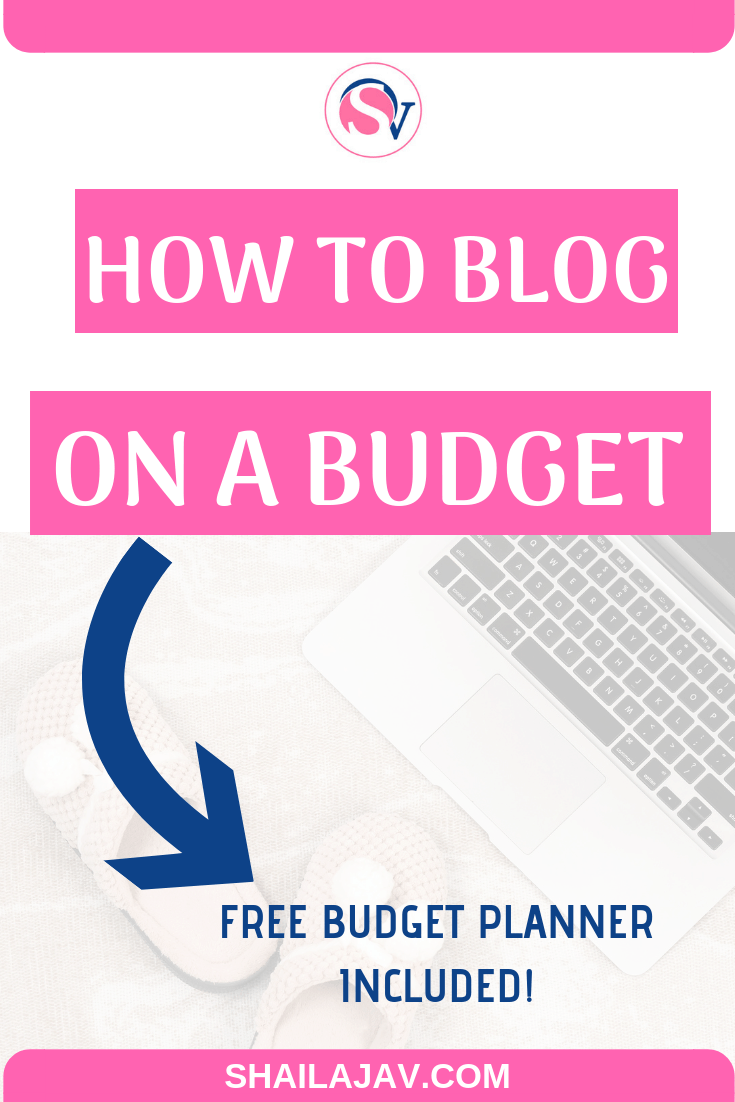A lot of bloggers (self included) start off as hobby bloggers. The idea of turning it into a business or as a way to make money isn’t something that strikes us until later.
But, you don’t have to be like me. With today’s tips you can plan your expenses and create a blog budget that will keep you organised and help you watch where your money is going.
Most of you will fall into two broad categories as bloggers: Blogging for fun and Blogging for Business. In many cases, those two overlap. But in the case of money, the expenses are poles apart.
For the purposes of this post, I am going to assume that you fall into the blogging for business category. Essentially, you’d like to make money from your blog.
This post contains Affiliate links. What that means is if you click on any of the links and make a purchase, I get a commission at no extra cost to you. If you do, I thank you for your purchase. Read my complete disclosure policy here.
Should you spend money on your blog?
Before we start anything about budgeting, I am going to answer this question. And I’m going to keep it simple. This is what I tell every single person who reaches out to me with a question on if they should buy a course that I recommend.
Do not spend money that you don’t have.
A lot of bloggers and course creators would love it if you buy their latest course or generate affiliate income for them. But the decision to spend money has to be solely yours.
This will depend on your budget, your income and your savings.
I’m not an accountant but I have kept track of money in terms of simple accounts and expenses for a long time now. So, in this post I am going to ask you to do a few things. Grab a pen and a notepad (or open up an excel sheet, if that works for you) Don’t worry, we’ll keep it real simple.
If you follow this and I highly recommend that you do, you will spend about 30 minutes a month drawing this up but have a clear vision on how to budget for your blog.
Take a fresh page and draw a table with two columns and label them as follows:
- Income
- Expenses
Next, create 3 sub-columns under each broad column and label them as given:
- Current
- Projected
- Actual
I’ve added a picture of a typical month of my personal budget. We will break it down further as we progress through the article.

Current Income

The current income tab is what you need to fill out on the 1st of the month or just a few days prior to the start of the new month. This is your opening balance.
Include your streams of revenue. For a blogger this could range from affiliate income and ad revenue to income from courses and digital products and services that you may offer.
December 2018 was a particularly good month for me, affiliate-income wise and I couldn’t be happier. This means that planning for 2019 just became a whole lot easier.
Totally credit this course by Carly Campbell for making it happen!

The current income tab gives you a clear vision of how much money you have already and how much you can afford to spend.
Projected Income

Under this column, write down a list of expected income for the month.
This will include pending payouts from affiliates as well as what you think you may make from other income sources.
If you’re not sure of any projected income, leave this blank or put a token amount. Keep it small initially. Over time, you can increase it.
Actual Income

This one’s easy. How much money did you actually make this month from your different revenue streams? That is your closing balance for each month.
Write that down in this column on the last day of the month. Now you can figure out the difference between the projected income and actual income and see where your revenue has been the best.
This will also be the amount that you carry forward to the next month under ‘Current Income’.
Current Expenses

Now that we’ve tackled income, it’s important to look at the range of expenses.
For instance, I know for a fact that self-hosted bloggers will have to spend on hosting each month. Granted, you will be shelling out money by the year and not by the month.
But breaking it down per month gives you a clearer picture of how much you are actually spending each month.
My hosting cost at the moment is $3 per month and will remain at that cost for the next 3 years.
Want to know more about my hosting provider? Read this (& don’t miss the special discount code at the end of that post)
Next, work out if you’d like to spend on items like social media scheduling tools. I personally recommend both Tailwind {Affiliate link} and Buffer.
Projected Expenses

We now come to the crux of this post. How much money are you ready to spend in addition to the ongoing expenses of your blog?
Based on your current income at the beginning of the month, set aside a portion for probable expenses.
This could include:
- A good course or bundle of courses
- A good paid plugin (such as a social media sharing plugin or a custom plugin like Tasty Pins {Affiliate Link} )
- Books/ Planners. I personally LOVE this one and THIS too. {Affiliate links}
- Possible hardware- A new laptop or microphone or camera.
Only make the investment if you are sure that the income from the previous month will cover these as well as leave some over for the closing balance.
Actual Expenses

At the end of the month, track how much you spent on both your current and projected expenses.
Remember to budget for savings at the end of the month.
Carry forward that amount to next month’s opening balance.
So, wasn’t that simple?
Now, do you have a clearer picture? To make it even clearer, I am answering a few frequently asked questions below.
FAQ:
1. What if I’m not making any money from my blog yet? How do I budget for expenses?
Answer: I’d say set aside a certain amount each month from your savings. If possible, you can cut back on a couple of things each month, say, eating out or buying books or clothes. This will depend on how serious you are about making money from your blog.
2. I want to buy a course but it’s expensive! I know I’ll get great value from it but I don’t have the budget right now.
Answer: Bookmark the course and sign up for the course creator’s newsletter. Usually, once every few months they will run a flash sale or have a discount on the price. That’s the best time to buy the course.
*Personally, the best investment is a bundle of courses like the ones run by Ultimate Bundles. You get up to 70+ courses for a fraction of the price.
3. Do you really think self-hosting is important? I am quite happy with my custom domain. Can I still make money from the blog?
Answer: Self hosting gives you way more flexibility than a custom domain. I’ve explained that in detail in this post. But, I know it can be a tad tricky for some people.
What I’d recommend is try out the custom domain for a few months or a year and see if you’re able to generate revenue. A good affiliate programme can work wonders. Later, you can choose to switch if you feel like it.
I do hope this post helps. As you enter the new year, work out your financial goals, your monetary vision for your blog and how you intend to make it happen.
Wishing you all the best. 🙂 And do share how you plan the budget for your blog too!
Ana of The She Approach also has a very reasonably priced product which will show you how to calculate your blogging income and expenses.
Click the image below for more details.




Immensely helpful. I have been struggling to monetize my blog, specially because I am very particular about the content that I post. I have refused a few paid promotions because I felt they didn’t align with the purpose of my blog. I am so glad that you have written this article because I finally see a way out without compromising on my principles.
Thanks, Sonia. I agree that it’s important to stay niche-focused and audience friendly when you accept any promotions. Just choose the right kind that align with your core values. You can’t go wrong.
I predominantly fall under the category of blogging for passion, but do earn a decent income through affiliate and sponsors( well, I havent planned for it. They just land up :)). My only expenditure is for the hosting. So far so good. :))
However this neat tabulation and structure mentioned in this post for those looking out to monetise their blog and where to invest, is making me rethink, maybe I should expand my horizon and look beyond my comfort zone..
That’s so wonderful to hear about the affiliates and sponsors that come your way! That’s the best thing, in my opinion. You can then focus on your content and let that do all the talking.
Definitely explore a few more options though if you’d like to monetize further. Good luck 🙂
Wow that’s a whole lot of planning you done. I haven’t thought of monetizing my blog yet, but if I do this is the place where I will get all my information. I am so impressed by your knowledge and the research and more by your zeal to share this information freely.
Thanks 🙂 Planning is the one thing that has helped me keep my head above water in this space. Else it can be quite overwhelming.
So pleased that you find it useful. And always happy to share what I know.
That’s a very handy post and it has reminded me I was meant to do my general budget before I went on holidays but I didn’t! That’s on the to-do list now! 😛 I don’t monetize my blog anymore given I’m using it as an author platform more than anything else so I’m definitely losing money on it but at this moment, it’s something I can still afford so thank goodness for that.
You make it so simple, Shy. I have been maintaining an annual balance sheet kind of thing this year (since today only I complete 1 year of blogging). So far, it has only been my hosting expenditure & one workshop. And your monthly table of Expenditure Vs Income would only make things more simple & error-free.
Thanks a lot for this post & every time you write a post about blogging, it feels like you can read the questions in my mind.
This is such an amazing post with so much information. Thanks for sharing and I am sure this post would help many people. I have written a detailed post on how to effectively reduce monthly blogging expense in 2019. You can check it out here:
https://www.createmytraffic/how-to-effectively-reduce-monthly-blogging-expense-n-2019
This is very attention-grabbing, You’re an excessively professional blogger.
I have joined your feed and sit up for searching for more of your great post.
Additionally, I have shared your website in my social networks.
Great post Shailaja, I agree no one should overlook the blog budget, even if you have started the blogging for fun at a point of time if you start spending more than any income you’re not doing a good deal. So, creating a proper blog plan is much needed. After going through this article I have upgraded my budgeting pattern too by including some of your points. Thank you for sharing such a descriptive article. Keep sharing.